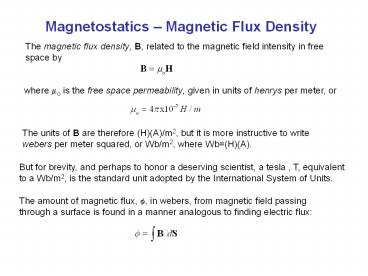Magnetostatics - PowerPoint PPT Presentation
Title:
Magnetostatics
Description:
But for brevity, and perhaps to honor a deserving scientist, a tesla , T, equivalent to a Wb/m2, is the standard unit adopted by the International System of Units. – PowerPoint PPT presentation
Number of Views:43
Avg rating:3.0/5.0
Title: Magnetostatics
1
Magnetostatics Magnetic Flux Density
The magnetic flux density, B, related to the
magnetic field intensity in free space by
where ?o is the free space permeability, given in
units of henrys per meter, or
The units of B are therefore (H)(A)/m2, but it is
more instructive to write webers per meter
squared, or Wb/m2, where Wb(H)(A).
But for brevity, and perhaps to honor a deserving
scientist, a tesla , T, equivalent to a Wb/m2, is
the standard unit adopted by the International
System of Units.
The amount of magnetic flux, ?, in webers, from
magnetic field passing through a surface is found
in a manner analogous to finding electric flux
2
Magnetostatics Gausss Law
A fundamental feature of magnetic fields that
distinguishes them from electric fields is that
the field lines form closed loops
We cannot saw the magnet in half to isolate the
north and the south poles as Figure shows, if
you saw a magnet in half you get two magnets.
Put another way, you cannot isolate a magnetic
pole.
From this characteristic of magnetic fields, it
is easy to see that the net magnetic flux passing
through a Gaussian surface (a closed surface as
shown in Figure 3.26) must be zero. What goes
into the surface must come back out. Thus we
have Gausss law for static magnetic fields
This is also referred to as the law of
conservation of magnetic flux.
3
Gausss Law and Kirchhoffs Current Law
Gausss Law The net magnetic flux passing
through a closed surface (Gaussian surface) must
be zero
Therefore, the algebraic sum of the currents
entering any closed surface is zero.
This is analogous to Kirchhoffs Current Law
(KCL)!
Kirchhoffs Current Law The algebraic sum of the
currents entering any node is zero.
4
Point form of Gausss Law
The divergence theorem states that the net
outflow of flux from a closed surface is equal to
the sum of flux outflow (and inflow) from every
point inside the volume enclosed by the surface.
Applying the divergence theorem, we arrive at the
point form of Gausss Law for static magnetic
fields
Integral Form
Point Form
Gausss Law
5
Magnetostatics Gausss Law
The differential, or point, form of Maxwells
Equations are easily derived by applying the
divergence theorem and stokes theorem to the
integral form of the equations.
Divergence Theorem
Stokes Theorem































